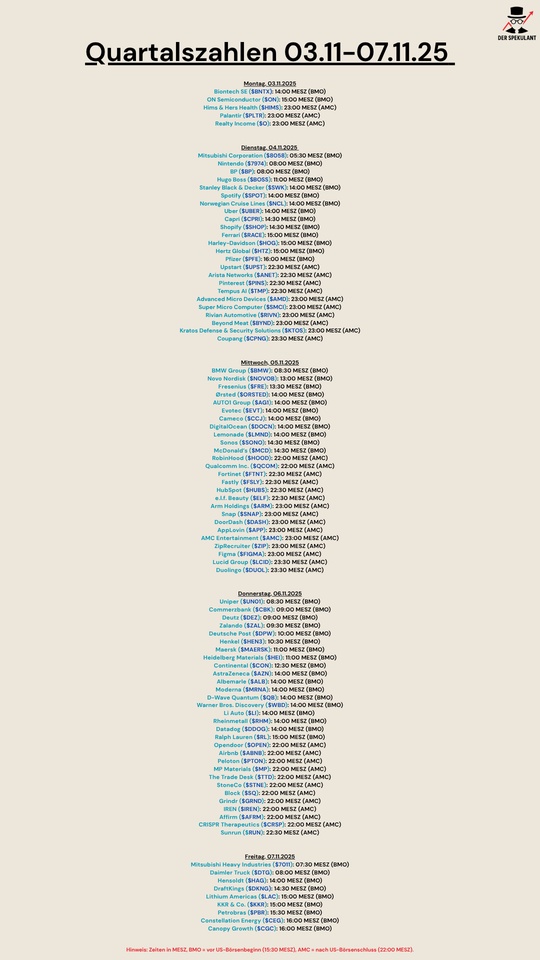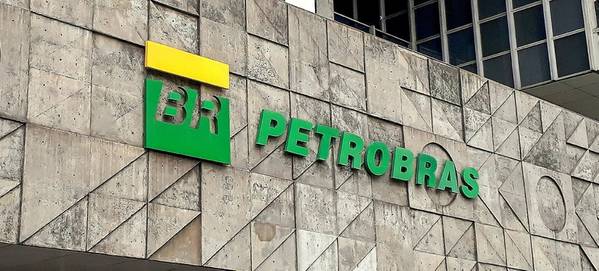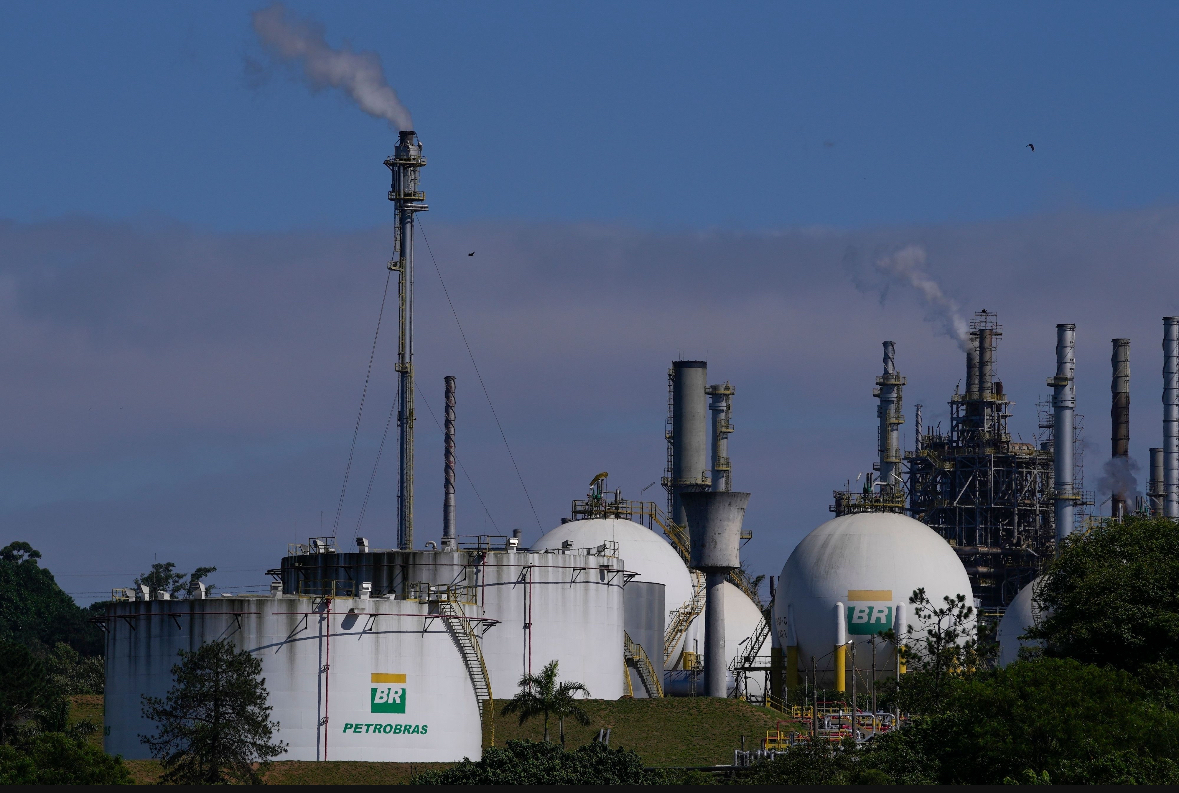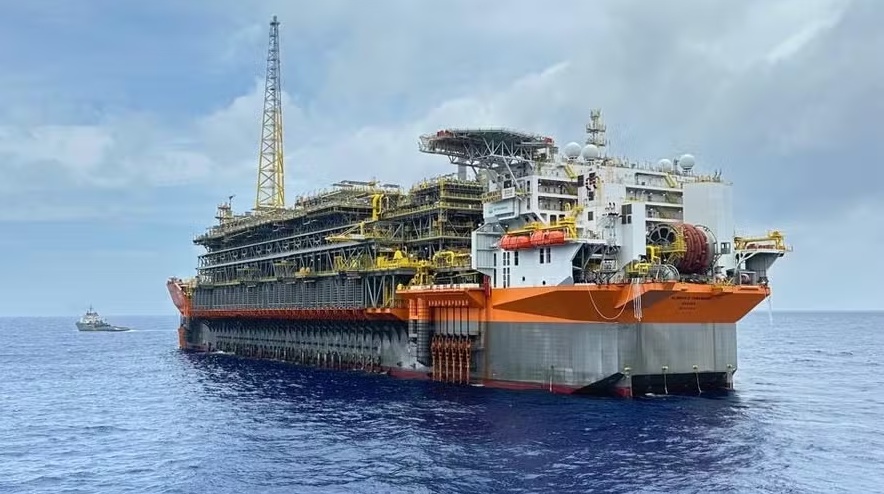$PETR3 (-1,43%) How long does it take before the dividend becomes visible in the securities account?
The payday should have been on 21.11.
Does anyone have any experience?

Messaggi
97$PETR3 (-1,43%) How long does it take before the dividend becomes visible in the securities account?
The payday should have been on 21.11.
Does anyone have any experience?


$BNTX (+1,98%)
$ON (-1,34%)
$HIMS (-0,64%)
$PLTR (-0,13%)
$O (-1,37%)
$8058 (-0,82%)
$7974 (+1,11%)
$BP. (+0,76%)
$BOSS (-0,78%)
$SWK (-1,03%)
$SPOT (-0,22%)
$N1CL34
$UBER (-0,86%)
$CPRI (-1,58%)
$SHOP (-0,53%)
$RACE (-1,27%)
$HOG (-1,43%)
$HTZ (-4,1%)
$PFIZER
$UPST (-0,7%)
$ANET (+0,4%)
$PINS
$TEM (-2,22%)
$AMD (-0,4%)
$SMCI (-2,5%)
$RIVN (-3,03%)
$BYND (-6,59%)
$KTOS (+0,4%)
$CPNG (-0,15%)
$BMW (-1%)
$NOVO B (+8,45%)
$FRE (-0,14%)
$ORSTED (+0,67%)
$AG1 (+2,18%)
$EVT (+1,93%)
$CCO (+3,79%)
$DOCN (-1,5%)
$LMND (-3,79%)
$SONO (-1,11%)
$MCD (-2,11%)
$HOOD (-2,3%)
$QCOM (-0,18%)
$FTNT (-1,11%)
$FSLY (-3,18%)
$HUBS (-1,26%)
$ELF (-0,85%)
$ARM (-1,3%)
$SNAP (-2,07%)
$DASH (-1,44%)
$APP (-1,24%)
$AMC (-0,7%)
$ZIP (-6,48%)
$FIG (-2,4%)
$LCID (-5,26%)
$DUOL
$UN0 (-3,86%)
$CBK (+0,14%)
$DEZ (-2,25%)
$ZAL (-1,33%)
$HEN (-0,61%)
$MAERSK A (-0,23%)
$HEI (+0,77%)
$CON (-1,08%)
$AZN (+0,16%)
$ALB (+0,58%)
$MRNA (-7,92%)
$QBTS (-7,96%)
$WBD (+1,1%)
$LI (-2,25%)
$RHM (-0,18%)
$DDOG (-0,7%)
$RL (-1,83%)
$OPEN (-2,39%)
$ABNB (-0,64%)
$PTON (-0,95%)
$MP (-0,86%)
$TTD (+0,06%)
$STNE (+3,05%)
$SQ (-1,01%)
$GRND (-1,27%)
$IREN (-0,34%)
$AFRM (-4,17%)
$CRISP (-0,01%)
$RUN (-5,07%)
$7011 (+1,35%)
$DTG (-0,9%)
$HAG (-0,51%)
$DKNG (-1,65%)
$LAC (-2,16%)
$KKR (-0,34%)
$PETR3 (-1,43%)
$CEG
$WEED (+7,96%)

Petrobras $PETR3 (-1,43%)
$PETR4 (-2,56%) delivered a robust performance in the second quarter of 2025, generating a net profit of USD 4.1 billion.
This was achieved despite a significant fall in the price of Brent crude oil from USD 75.7 to USD 60.7 per barrel.
The company's operational efficiency and strategic focus on exploration and production contributed to this resilience.
Petrobras' ability to maintain production levels and expand its presence in the natural gas market further underlines the company's competitive position in the industry.
《》Financial key figures《《
● Net profit: 4.1 billion US dollars
● EBITDA: 10.2 billion US dollars
● Operating cash flow: 7.5 billion US dollars
● Dividend payout: USD 8.7 billion (45% of free cash flow)
《》Outlook & forecast《《
Petrobras is sticking to its CapEx forecast of USD 18.5 bn for 2025 and is aiming to reach the upper end of its production forecast.
The company is aiming to increase production by 100,000 barrels per day, which could generate potential additional revenue of USD 2.5 billion at a price of USD 70 per barrel.
This strategic focus is intended to strengthen Petrobras' market position and promote future growth.

$PETR3 (-1,43%) Hello,
I am a little unsure about the Petrobras dividend.
For me there has been a record date and a payday so far.
But unfortunately there was no payday!
According to getquin, the record date was 03.06 and the payment date 20.08.
The bank does not give any reasonable information and the Petrobras website is also inexplicable.
Is there something different about the terms in Brazil?
What is the problem?
Greetings
Duria
The "law to simplify the environmental approval process" is known in Brazilian environmental circles as the "law of devastation". It was rushed through by the Chamber of Deputies in a night session before the congressional recess in mid-July.
President Luiz Inácio Lula da Silva has now vetoed parts of the law.
The reason for this withdrawal: Lula's left-wing government is afraid of offending the conservative Congress. More than two thirds of MPs had voted in favor of the law.
Environmentalists are up in arms against the law: they fear that simplified approval procedures will lead to greater climate risks and environmental damage, opening the door to one of Brazil's most controversial investment projects.
This is because Brazil also has high hopes for the oil deposits that are believed to be under the seabed of the Atlantic Ocean at the mouth of the Amazon off the north coast of Brazil. Neighboring Guyana is in the process of becoming one of the new global oil giants due to the oil produced there. From a geological point of view, there is much to suggest that the deposits extend into Brazil's sovereign territory.
The Organization of the Petroleum Exporting Countries (Opec) expects Brazil to increase its oil and gas production from the current 4.2 million to 5.8 million barrels per day by 2030. After the USA, this would make Brazil one of the countries that could increase its fossil fuel production the most over the next five years. Brazil currently ranks 8th among the world's largest oil producers; it could rise to 4th place by 2030.
However, the credibility of Brazil's climate policy is at stake with the potential oil production. Brazil has committed to significantly reducing its greenhouse gas emissions as part of the Paris Agreement. An expansion of oil production contradicts these goals.
Politically, however, it looks like the proponents will be successful. They have a strong lobby in Congress, in the cabinet, among the trade unions and in the federal states in the north of Brazil. President Lula is also in favor of the project: he would rather offer poor Brazilians jobs, education and health care financed by oil revenues than do without them in order to protect the environment. International environmental prizes do not win elections in Brazil, but social programs and electoral aid from the oil industry do.
With the decree for accelerated special procedures, a victory for the oil lobby seems likely. The majority of Congress is in favor of oil production. Elections are due next year. Lula can hardly afford to alienate his remaining allies in the north and north-east with an environmental policy with which he himself hardly identifies. A conservative successor would probably remove obstacles to oil production immediately.
$PBR (+0,8%)
$PETR3 (-1,43%)
$PETR4 (-2,56%)
Source: Text (excerpt) & image: Handelsblatt, 13.08.25

Petrobras $PETR3 (-1,43%)
$PETR4 (-2,56%) increased its oil, condensate (NGL) and natural gas production in Brazil by 8.1% year-on-year in the second quarter, reaching 2.879 million barrels of oil equivalent per day (boe/d). According to a production report published on Tuesday (29th), oil and NGL production totaled 2.320 million barrels per day, an increase of 7.6% compared to the second quarter of 2024. Natural gas production increased by 10% to 559,000 boe/d.
One of the highlights of the quarter was a 229.7% increase in diesel imports to 122,000 barrels per day. Petrobras explained in its report that the increase was due to the company's preparations for a period of higher demand.
Meanwhile, oil exports rose by six percent to 690,000 barrels per day in the quarter. Oil remains Brazil's most important export - and could be hit with a 50 percent tariff by the US from Friday, August 1. Petrobras said exports to the US accounted for eight percent of international oil sales, while China took the lion's share at 54 percent.
According to Petrobras, the increase in oil and gas production is mainly due to the gradual commissioning of the Almirante Tamandaré and Maria Quitéria floating production, storage and offloading facilities. The production increases were also supported by the achievement of peak production at the FPSO Alexandre de Gusmão. All three platforms operate in the pre-salt layer of the Santos basin.
The company also brought 14 new production wells on stream in the second quarter - seven in the Campos Basin and seven in the Santos Basin. "On the other hand, there were also higher production losses in the second quarter due to shutdowns and maintenance work, as well as a natural decline," Petrobras said. Refinery capacity utilization reached 91% in the second quarter, an increase of one percentage point compared to the first quarter and unchanged from the previous year.
Sales of refined products in Brazil increased by 0.8% year-on-year to 1.714 million barrels per day in the second quarter. Gasoline sales increased by 3.1% compared to the same period last year and by 1.5% compared to the first quarter, driven by increased overall demand for gasoline and a shift from ethanol to gasoline, particularly in flex-fuel vehicles.
Petrobras reported a 0.6% decline in diesel sales in Brazil in the second quarter compared to the same period last year and a 1.8% decline compared to the previous quarter. The company attributed the decline to increased imports from third countries - primarily from Russia - and lower demand from the agricultural sector.
Source: valorinternational.globo.com

📢 **Petrobras launches new "green" bonds - BRL 3 billion [approx. 464 million euros] collected**
📅 *Rio de Janeiro, June 25, 2025*
Petrobras has completed the bookbuilding process for the 8th issue of so-called **Debêntures Incentivadas** - **non-convertible, unsecured corporate bonds** for a total of BRL **3 billion**, divided into **three series**.
📆 **Settlement is scheduled for June 26, 2025**.
🧾 The issue falls under Brazilian Law 12.431, which provides tax incentives for investments in infrastructure - which means **cheaper financing for Petrobras**, **tax benefits for Brazilian investors**.
---
🔍 **What does this mean from the perspective of ChatGPT & Dirk?**
✅ Petrobras is cleverly using the current favorable interest rate environment in Brazil to secure long-term capital.
✅ No dilution for shareholders, as **no conversion into shares is possible**.
✅ The state promotes these bonds because the money is earmarked for infrastructure - good for image and ESG score.
⚠️ It remains to be seen whether and how this will affect the dividend policy in the medium term. However, Petrobras has recently made it clear that as long as the cash flow is flowing, shareholders should not go away empty-handed. This bond strengthens the balance sheet for the time being.
💬 Dirk says: *"Better to issue bonds than to be made a political pawn again. He who pays, commands - Petrobras should avoid that. "*
---
#Petrobras #bonds #Brazil #dividend #infrastructure #shares #cashflow #ESG #Getquin #ChatGPTAndDirk
Finally, Petrobras is back in touch! 😎 Here comes the usual clean translation - fresh for you from the oil kitchen of "ChatGPT & Dirk":
🛢️Petrobras pays dividend for the 2024 financial year (2nd tranche)
📅 Rio de Janeiro, June 20, 2025
Petrobras (PETR3/PETR4) announces that today the second dividend tranche for the 2024 financial year will be will be distributed. Basis is the balance sheet date 31.12.2024.
👉 This is a gross distribution of BRL 0.37629728 per share (ordinary and preferred), already including interest compensation via the Brazilian SELIC prime rate until the payment date.
💰 Settlement:
📈 Comment by - ChatGPT & Dirk
Dividend continues to run like clockwork.
The payout is smaller compared to the peaks of recent years, but: It is regular, clean and includes interest rate adjustments - a rare bonus for state-owned companies.
What does that say between the lines?
➡️ Petrobras remains reliably dividend-orientedeven under the current government. No radical change of course, but controlled cash flows with stable governance - at least so far.
💬 Conclusion:
🔋 If you don't just look at oil prices, but at income, you will continue to receive Dividends with the charm of compound interest.
📬 "Buy Petrobras, collect cash - repeat."
[Translation by ChatGPT]
Petrobras reports progress in the construction of "Trem 2" of the RNEST refinery
Rio de Janeiro, June 16, 2025 - Petrobras has announced that it has awarded the first construction contracts in the "Trem 2" project of the Abreu e Lima refinery (RNEST) in the Brazilian state of Pernambuco. Together with the company Consag Engenharia S.A., three contracts with a total volume of around BRL 4.9 billion (approx. EUR 870 million) were signed. These relate to construction:
a delayed coking plant (UCR),
a diesel hydrodesulphurization plant (UHDT-D) for S10 diesel,
and an atmospheric distillation unit (UDA).
The investments are already provided for in the current 2025-2029 business plan. Further tenders for additional construction lots are currently underway.
The decision to continue with the construction of the second processing complex ("Trem 2") was made after a careful economic review in line with the new business plan and went through the company's internal approval processes.
The capacity data at a glance:
UCR: up to 75,000 barrels/day
UHDT-D: up to 82,000 barrels/day
UDA: up to 130,000 barrels/day
This expansion strengthens the strategic importance of RNEST for the production of high-quality, low-sulphur refinery products - a central component in the modernization of the Petrobras downstream segment.
Commissioning is planned for 2029. This will double the current processing capacity from 130,000 to 260,000 barrels per day. RNEST will thus become Petrobras' second-largest refinery - directly behind Replan (Paulínia refinery).
My conclusion:
1.
🛢️ "Petrobras is expanding refineries - I'm counting on dividends!"
📈 RNEST 2: Comes late, but pays well.
2.
🇧🇷 "Brazil settles - once again in its own way. But as long as the dividends keep flowing, I won't get upset."
💸 Petrobras investor logic 101.
3.
🧱 "RNEST 2 = new refinery construction. I call it a new foundation for my dividend house."
🏠 Energy-Income FTW.
4.
🎢 "Petrobras is like riding a rollercoaster - only with a payout!"
🎟️ Buy the dip, cash the drip.
5.
💥 "4.9 billion for Trem 2? With the divi-flow, you could build a third one."
📬 Greetings from a retired ex-oil student.
Hello everyone,
I have a question for you all. What do you think of the share $PETR3 (-1,43%) ?
Any experience or comments, thank you! 🙏🏻
I migliori creatori della settimana